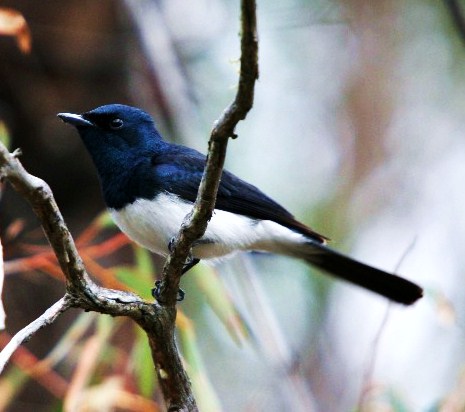Myiagra cyanoleuca
 |
| Photo by Lindsay Hansch (Internet Bird Collection) |
Common name:
satin flycatcher (en); monarca-acetinado (pt); monarque satiné (fr); monarca satinado (es); seidenmyiagra (de)
Taxonomy:
Order Passeriformes
Family Monarchidae
Range:
The satin flycatcher is found breeding in eastern Australia, down to Tasmania, and in New Zealand. They migrate north to winter in northern Australia, Papua New-Guinea and Indonesia.
Size:
These birds are 15-18 cm long. They have a wingspan of 23 cm and a weight of 17 g.
Habitat:
Satin Flycatchers mainly inhabit eucalypt forests, often near wetlands or watercourses. They generally occur in the moister, taller forests. During migration they can also be found in coastal forests, woodlands, mangroves and drier woodlands and open forests.
Diet:
These birds are mainly insectivorous, preying on arthropods, mostly insects, although very occasionally they will also eat seeds. They are arboreal foragers, feeding high in the canopy and sub-canopy of trees, usually sallying for prey in the air or picking prey from foliage and branches of trees.
Breeding:
Satin flycatchers breed in September-March. They nest in loose colonies of 2-5 pairs nesting at intervals of about 20-50 m apart. Both sexes build the nest, a broad-based cup made of shredded bark and grass, coated with spider webs and decorated with lichen. The nest is placed on a bare, horizontal branch, with overhanging foliage, about 3-25 m above the ground. There the female lays 2-3 greenish blue eggs with brown spots. The eggs are incubated by both sexes for 17 days. The chicks are fed by both parents and fledge 18 days after hatching.
Conservation:
IUCN status – LC (Least Concern)
This species has a very large breeding range. Although the population size is yet to be quantified, the species is described as common in the south of its range, but scarce in the north. This population is estimated to be in decline following decreases owing to habitat loss and degradation.







